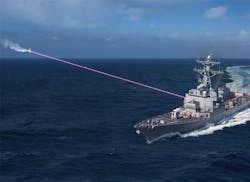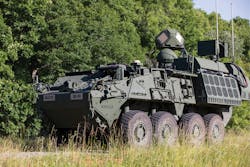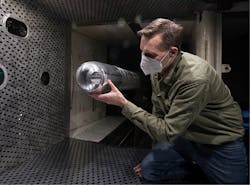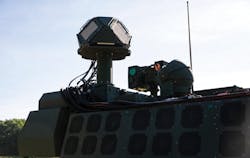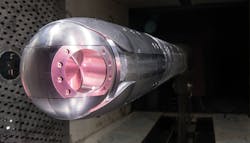High-energy laser weapons ready for the front lines
By Megan Crouse
NASHUA, N.H. - High-energy and laser weapons seem to be perpetually on the metaphorical horizon. Over the decades, the U.S. military has tested them for a variety of applications, from blinding sensors to disabling enemy vehicles.
Field tests in the last few years prove the interest of government and industry in demonstrating lasers with increasing wattage. There also is the matter of practicality: mounting a largely experimental weapon on a vehicle that may jostle on wheels over rough ground or reach high speeds in flight is an added challenge. Still, the industry is showing interest in making it a reality.
Types of lasers
Practical laser beams for defense can fall into one of two categories: distributed gain — a series of slabs through which energy is beamed serially; and spectrum beam — a combination of fiber lasers similarly to what one might see in fiber communications. Fiber lasers were developed originally for industrial cutting and welding. While there are a variety of other ways to classify the components, these are two major distinctions.
“High-energy weapons” or “directed energy” is the larger category that can include lasers. It might also refer to RF and microwave sources used as weapons, which some refer to as electromagnetic weapons. These have been demonstrated for non-lethal use against people
Other examples of high-energy weapons can include sound-based weapons, as well as a theoretical “particle beam.” While there is an element of speculation to this field overall, some signs do point to laser weapons becoming more practical.
Uses of laser weapons
In the past, defense experts theorized that lasers might be best for blinding enemy sensors or obscuring the vision of pilots of aircraft or helicopters. Today, theOn the Defense Matters podcast in March 2022, retired U.S. Air Force Col. Mark Gunzinger, former director at the Mitchell Institute for Aerospace Studies and former deputy assistant secretary of Defense, pointed out that the Defense Department is seriously investing in lasers.
“Over the years I’ve seen a constant level of funding somewhere between $500 million and $600 million per year going into research and development for all kinds of directed energy capabilities,” Gunzinger told Defense Matters. “That has been almost doubled in the last budget, but still, if you think about hypersonic weapons, that last budget was about $3.8 billion for hypersonic weapons. So directed energy research development and some acquisitions is still about a third of that.”
Electromagnetic weapons that use high-power microwave energy have several advantages over conventional weaponry, Gunzinger said. As long as the weapon has electric power, it does not need to carry ammunition or to reload. That also means there essentially is no supply chain necessary for operation. This means the weapon can move around frequently. Moreover, it's a good fit for distributed operations that reduce their vulnerability to attack.
However, Gunzinger notes, the efficacy of laser weapons may be reduced by certain weather conditions. Therefore, he said, the military needs kinetic and non-kinetic weapons to be able to work together in the same place. Likewise, fire control systems need to be able to integrate both.
A war game in January at Kirtland Air Force Base, N.M., demonstrated one of these joint fire applications. As its name suggests, the Directed Energy and Kinetic Energy Directed Energy Utility Concept Experiment provided an early look at using directed energy and conventional weapons under the management umbrella of an artificial intelligence (AI)-enabled battle management system. They included a laser pod mounted on an aircraft and two “future kinetic concepts” as part of the virtual test.
Gunzinger notes that practical lasers for missile defense or other applications seem perpetually to be 10 years out. However, he also pointed out that recent developments indicate we may at least be in a period of rapid iteration and activity in this area. Over the last six years, U.S. tests have gone from 60-kilowatt lasers to 300-kilowatt lasers. In another two years, Gunzinger predicts, the U.S. will be fielding 300-kilowatt and possibly even 500-kilowatt systems. He predicts megawatt-class lasers will enter the conversation in the next five years.
Experiments with ground vehicles
One way to solve a laser weapon’s need for power is to build it onto its own vehicle. Adding the additional variables that come with a mobile platform also adds challenges.
Integration needs to include factors like available volume, weight, how much power and cooling it needs, and placement, says Dr. Robert Afzal, Lockheed Martin Aculight senior fellow in laser and sensor, in Bothell, Wash.
“What are the vibration and shock environments?” says Afzal. “What temperatures will the system be exposed to? What other considerations like air pressure, salt spray, waves, dust or other conditions. Design choices are made to balance survivability with performance.”
Mobile lasers today may also include portable generators. As we reported last year, one of the projects the U.S. government has its eyes on in a very public way is the army’s test of 50-kilowatt lasers on Stryker combat vehicles. Since last year, this has undergone more testing. The Army tested M-SHORAD (Maneuver-Short Range Air Defense, built by Raytheon) in May, a vehicle-mounted laser which runs power from a gasoline-fueled generator.
They worked with Kord Technologies in Huntsville, Ala.(a subsidiary of KBR), to integrate the 50-kilowatt weapon onto an eight-wheeled Stryker combat vehicle from General Dynamics Land Systems in Sterling Heights, Mich. The laser was able to track, target and defeat 60-millimeter mortar rounds and drones in three different sizes during a test at White Sands Missile Range in New Mexico. This is part of a legacy of fitting more powerful lasers on smaller and more mobile footprints.
The M-SHORAD system also demonstrates the way a laser can integrate into wider command and control nets. While it includes a radar system, it can also connect to air picture from the Terminal High Altitude Area Defense command and control (THAAD C2). Rapid deployment is currently planned for 2022.
Craig Robin, deputy director of the RCCTO DE Project Office, told the AFCEA’s Signal Magazine in August 2021 that the Army has three directed-energy projects in the works. M-SHORAD is one of them, as well as another high-energy laser project and a high-power microwave weapon project made to defend against close-range swarms of drones.
“With an effectively infinite magazine and near-zero cost per shot, [High Energy Laser] is now the proven answer to asymmetric threats like drones and mortars,” Byron Bright, president of KBR Government Solutions, said in a news announcement.
The Army has been seeking solicitations for a 300-kilowatt laser weapon in 2021 and 2022, as well as awarding some projects for practical testing.
“Systems are demonstrating they can be effective against a variety of threats. There is still much learning to be had as the systems move from demonstrations to field deployment,” said Afzal.
In particular, Lockheed Martin and the U.S. Office of Naval Research (ONR) in Arlington, Va., demonstrated the Layered Laser Defense (LLD) laser weapon system could defeat a surrogate cruise missile at tactically relevant ranges in April.
Designed and built by Lockheed Martin, the LLD is a multi-domain, multi-platform demonstration system. Its 100-kilowatt-class spectrally beam combined high energy laser was chosen because it "exhibits excellent beam quality and aim point precision throughout engagement of increasingly challenging targets and a growing range of threats,” Afzal said.
Like other laser tests we’ve mentioned recently, targets for the LLDs included unmanned aerial systems, rockets, artillery and mortars and fast-attack boats.
There also have been some efforts to use laser weapon systems on even smaller vehicles. Forbes reports a 10-kilowatt laser weapon from Raytheon for the Air Force was developed to ride along on a Joint Light Tactical Vehicle (JLTV), and a custom military vehicle the size of a dune buggy. Its four main subsystems — the laser unit itself, the energy magazine or battery, the power system and the thermal management — all fit on the back of the vehicle, plus a basketball-sized beam director for targeting moving drones.
This system uses fiber laser amplifiers to combine multiple—kilowatt beams from relatively small amplifiers, decreasing the footprint. Commercial technological improvements in terms of fiber lasers and electricity storage enabled this downsizing.
“Another example is the energy storage capability that we get from advanced lithium-ion batteries out of the hybrid vehicle industry. These allow us to store hundreds of seconds of clean, on-demand, and rechargeable HEL power in a compact package,” Evan Hunt, high energy laser business development lead at Raytheon, told Forbes in September 2021.
Afzal notes that every development builds on the next, particularly when it comes to making these systems hit those magic words: smaller and more affordable.
“Our past R&D successes include a prototype 30-kilowatt laser in 2013 (ALADIN) and a complete end-to-end laser weapon system in 2014 (ATHENA),” he said. “Looking ahead, Lockheed Martin is scaling from this proven foundation to develop subsystems that enable higher-power mission capability within incrementally smaller volumes. These current and future advancements will provide tactical and strategic advantages that shift the cost calculus for customers.”
Ship-mounted lasers continue tests
Working off of a ship’s onboard electricity eliminates a laser weapon’s need for kinetic ammunition. The Navy has taken delivery of the 60-kilowatt High-Energy Laser with Integrated Optical Dazzler and Surveillance, or HELIOS, from Lockheed Mission Systems and Sensors. This is one of several projects in this area being worked on by the Navy.
“The question is going to turn more to funding priorities, price points, the capacity of our industry primes, and the supply chain that could build these things in full quantities and at scale and then, ultimately, conversations around doctrine and how they would actually be employed in combat,” Rambeau said.
In December 2021 the Navy tested another system, the Solid State Laser - Technology Maturation Laser Weapons System Demonstrator (LWSD) Mark 2 MOD 0, on drone targets or small boats. This builds on what the Navy learned from three years of testing their 30-kilowatt laser system aboard the amphibious transport dock USS Ponce.
Directed energy for fighter jets faces delays
Making laser systems small enough to sit in back of a dune buggy also helps make it possible to install them aboard fighter jets, although this is the ultimate test of limitations in size, weight, and power consumption (SWaP). With every inch and pound of space on an aircraft accounted for, adding one system threatens to require the removal of another. However, there have been some developments in this area.
Lockheed Martin is working with the Air Force Research Laboratory (AFRL) on the Self-Protect High Energy Laser Demonstrator (SHiELD), a directed energy system meant to be mounted on an F-15 to defend against incoming missiles. However, this program and others like it have faced some notable delays.
Lockheed Martin, Boeing, and Northrop Grumman have worked together on the SHIELD program. Originally planned for 2021 and now slated for possible demonstration in 2024, SHIELD has been delayed by COVID-19 and technical limitations. The technology is still catching up to the required power levels, beam stability, ability to defend against ballistic missiles at very short range, and the ability to operate under heavy atmospheric turbulence.
Skeptics like former U.S. Department of Defense (DOD) head of Research & Engineering Mike Griffin also have cited support requirements as hurdles that will provide a lot of challenges before high-powered directed energy systems can go airborne. At high-speed, the pods must be able to stand up against constant high wind and high G forces.
However, Harrison added, “Directed energy systems like this are likely the future of air and missile defense for airborne platforms because they can provide a much larger magazine of shots than kinetic interceptors. This is the most viable way to shift the cost exchange ratio in favor of the defender.”
Other decision-makers involved in this area, such as former Assistant Secretary of the Air Force for Acquisition, Technology, and Logistics Will Roper, have discussed focusing on using directed energy against drone swarms instead of trying to intercept missiles in flight from the air. Still others have proposed a ground-based laser could do the job of defending against missiles better than a system onboard an aircraft could. It’s uncertain whether getting a directed energy weapon to work in such extreme conditions as on board an aircraft will be plausible without prohibitive amounts of time and money.
The Drive pointed out in August 2021 that wind tunnel tests highlight the complications and how the possibility of an aircraft-mounted laser is getting some serious consideration. In the Aerodynamics Branch of Arnold Engineering Development Complex (AEDC) at Arnold Air Force Base, Tennessee, engineers tested what happens to a directed energy weapon when the aircraft it’s mounted on travels at Mach 2.0. It’s an effort almost eight years in the running.
One major concern is flow mitigation, which required an “aerodynamic fence” to be built around the turret containing the directed energy weapon in order to maintain acceptable beam quality. This project also assumes the directed energy weapon system’s pod will be equipped on a F-15 fighter.
The Army also flight-tested a solid-state laser pod on an AH-64 Apache attack helicopter back in 2017. In 2014, Lockheed Martin experimented with a directed energy turret on a Dassault Falcon 10 business jet.
What’s next for industry?
Afzal says that, in general, customers are starting to ask more specific and pointed questions about the entire laser weapon life cycle.
“For example, we are seeing an increased emphasis on training and warfighter touch points, as well as conversations around how to optimally establish global sustainment and support infrastructure,” he said. This may be a sign that more stake holders are seeing production as a practical consideration.
“Customers are also interested in laser weapons scaling to address additional mission areas, and inquiries along those lines entail how systems can grow in capability to take on a greater diversity of threats,” he said.
Dr. Rich Roberts, chief of the Aerodynamics Branch Store Separation Section of Arnold Engineering Development Complex, also says the tests will have results that will be able to feed information back into industry even if the laser pods don’t end up being deployed.
“As more directed-energy systems are developed and integrated onto aircraft, we’ll be able to help with design decisions, creating employment envelopes, defining adjacent weapons load-outs and other things routinely needed by program offices and manufacturers,” he told The Drive.
China and Russia
While it can be difficult to pin down adversary capabilities, the war in Ukraine has brought laser weapons back into the headlines. For a few years now, the Pentagon has been taking seriously possible threats to U.S. satellites from Russia or China-based lasers pointed toward space. In May 2022, Reuters reported Russia claimed the use of lasers to burn through drones in Ukraine.
Conversely, Ukrainian President Volodymyr Zelenskiy compared this to “propaganda ... about an amazing weapon” released by the Nazis in an attempt to prevent their defeat in World War II.
While whether Russia might be focusing on burning drones or dazzling satellites may be unclear, 2022 Defense Intelligence Agency report also focuses on the potential for lasers that can “dazzle” or damage satellites from China and Russia.
Electronics considerations
With high-energy comes the need for technological leaps and other input from microelectronics organizations. Last April a division of DARPA asked for enabling technologies in four areas, which have applications in areas including high-energy laser weapons:
- embedded microsystem intelligence and localized processing
- next-generation front-end component technologies for electromagnetic spectrum dominance
- microsystem integration for increased functional density and security
- disruptive defense microsystem applications in general.
Officials of the DARPA Microsystems Technology Office (MTO) highlighted these as topics not fully addressed by other MTO solicitations. Abstracts are due Jan. 6, 2024. Their inclusion on this list shows the commitment DARPA is making to exploring directed energy component technologies.
DARPA also noted other areas that prove challenges for development of high-energy laser weapons. In February, DARPA issued a broad agency announcement seeking technologies for better beam quality, SwaP considerations, and other improvements. The multi beam-combined high-power amplifiers and large, complex optical subsystems needed for high-energy weapons do not scale well, the agency reported.
On the other hand, today’s coherent beam combined-tiled array high-energy laser sources are more scalable. The desired tiles contain laser emitters whose phase can be sensed and controlled continuously to achieve coherent beam combination. Arranging several to several hundred of these tiles allows for scalable output power for a panelized, gimbal-mounted laser weapon source.
Coherently beam-combined tiled arrays can generate and project the laser beam directly without bulk optics, DARPA said. A tiled array is intrinsically scalable, as it has no inherent limits. It can also perform non-mechanical beam steering for beam jitter corrections and apply complex phase corrections to compensate for atmospheric disturbances.
This project is looking to capitalize on the military-commercial symbiosis between the development of technologies such as semiconductor fabrication techniques, coherent beam combining, photonic integration, and 3D integration and packaging.
Making directed energy weapons that can burn through drones or missiles from the back of a relatively small vehicle are still a technical challenge. However, it’s one on which progress has been made in the last five years.
